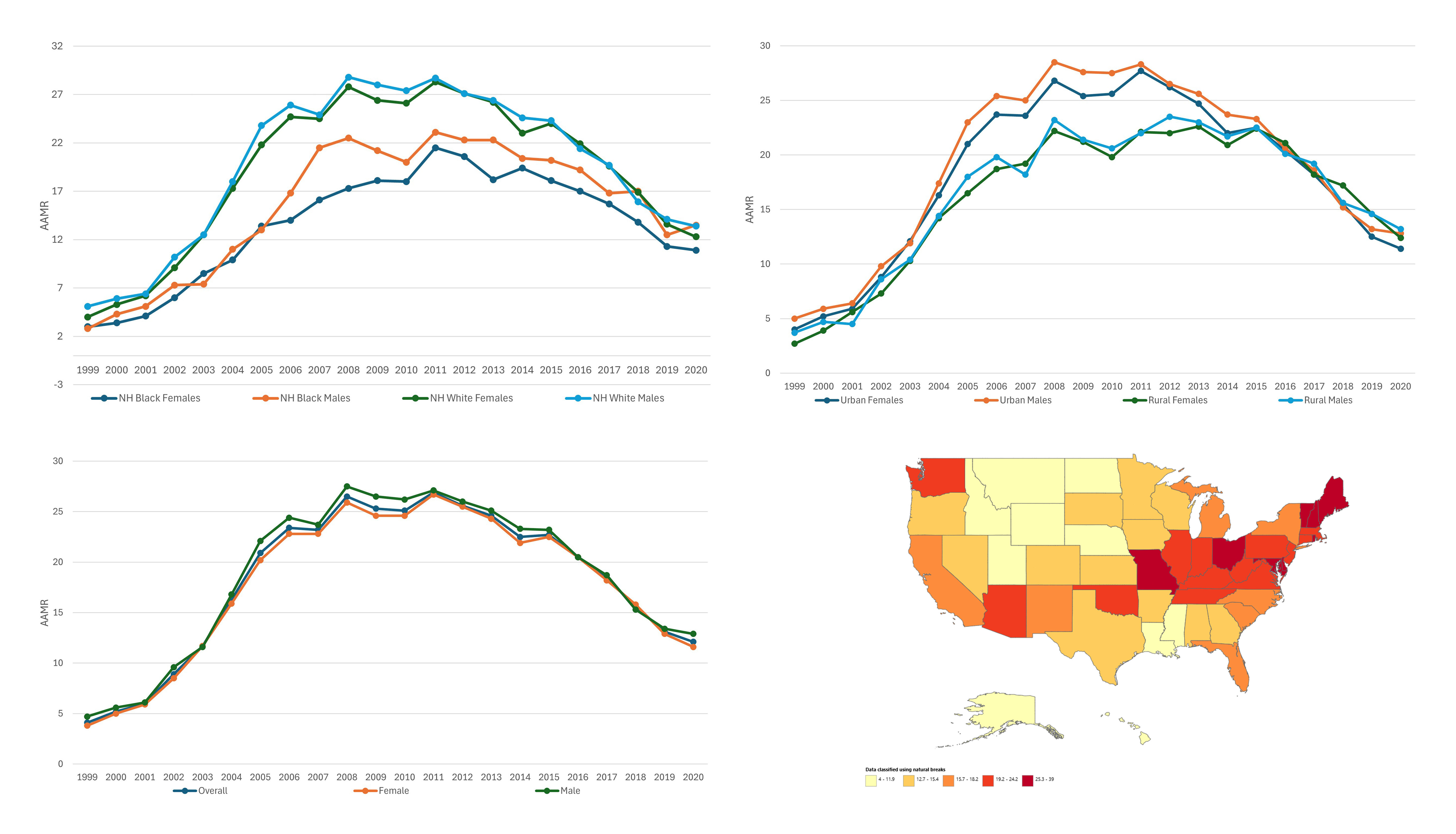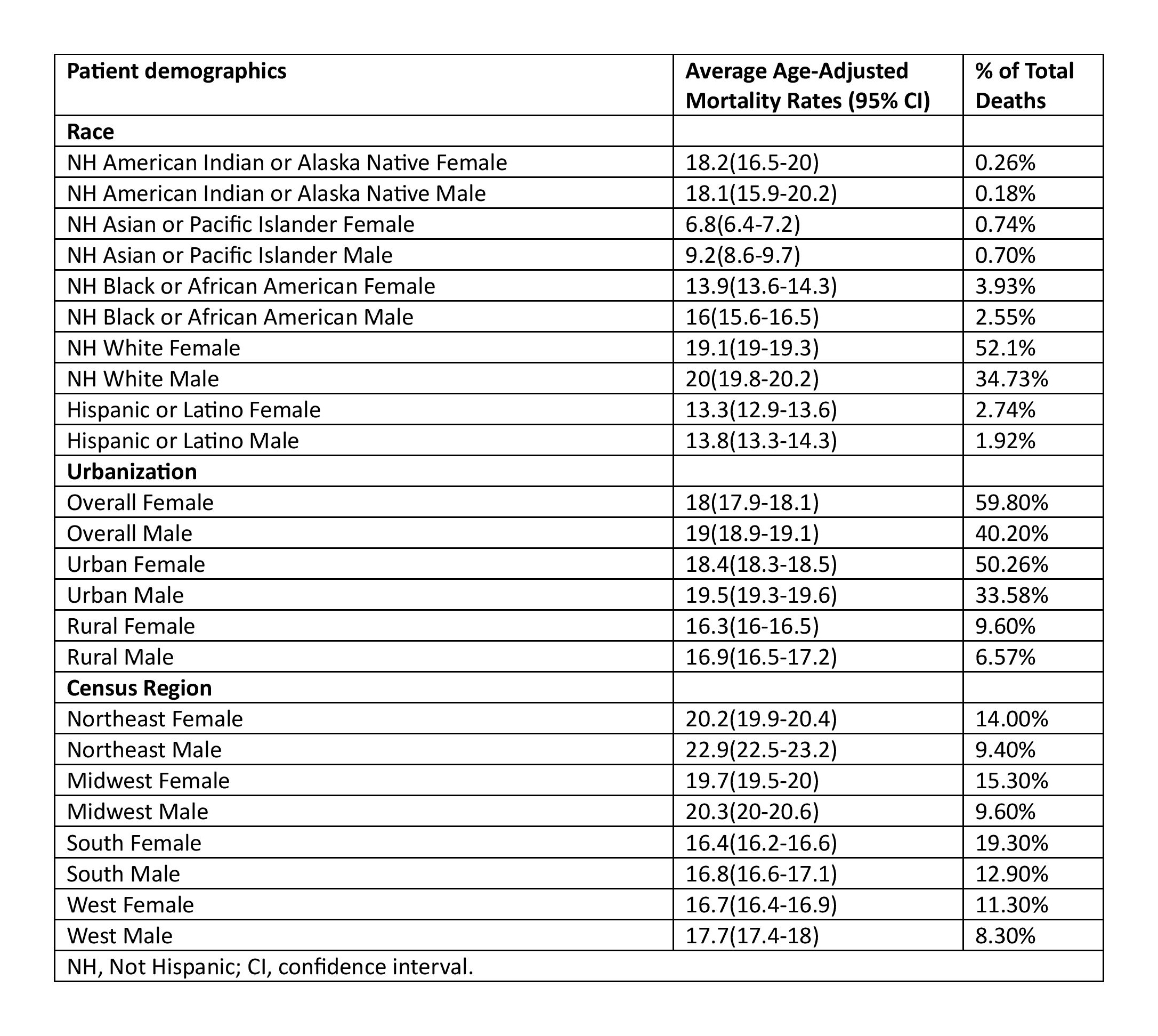Sunday Poster Session
Category: Infections and Microbiome
P1280 - Clostridioides difficile Infection-Related Mortality Trends Among Older U.S. Adults (1999-2020): A Nationwide Analysis of Disparities by Race, Region, and Urbanization
Sunday, October 26, 2025
3:30 PM - 7:00 PM PDT
Location: Exhibit Hall

Zainab Rafaqat, MD
University of Oklahoma Health Sciences Center
Oklahoma City, OK
Presenting Author(s)
Zainab Rafaqat, MD1, Umar Abdul Rehman Khalid, MBBS2, Abdul Haseeb Hassan, MBBS2, Muhammad Faiq Akram, MBBS3, Maham Maqsood, MBBS3, Ijlal Akbar. Ali, MD4
1University of Oklahoma Health Sciences Center, Oklahoma City, OK; 2King Edward Medical University, Lahore, Punjab, Pakistan; 3Allama Iqbal Medical College, Lahore, Lahore, Punjab, Pakistan; 4University of Oklahoma, Oklahoma City, OK
Introduction: Clostridium difficile infection (CDI) remains a major cause of morbidity and mortality in older adults in the United States. While previous studies have highlighted its burden in hospitalized and long-term care patients, nationwide mortality trends and their shifts over time remain underexplored. This study investigates CDI-related mortality among adults aged ≥65 in the U.S. over two decades.
Methods: Using CDC WONDER data (1999-2020), we identified CDI-related deaths (ICD-10 code A04.7) among adults aged >=65 years. Age-adjusted mortality rates (AAMRs) per 100,000 were calculated and stratified by sex, race/ethnicity, state, census region, and urbanization level. Joinpoint regression was used to estimate annual percent changes (APCs) with 95% confidence intervals (CIs).
Results: A total of 169,229 CDI-related deaths were recorded. AAMRs increased sharply from 1999 to 2005 (APC: +34.5%; 95% CI: 32.0-37.9), followed by slower increases until 2011 (APC: +3.6%; 95% CI: 2.1-6.0). A decline began in 2011 (APC: -5.7%; 95% CI: -8.1 to -2.8), accelerating through 2020 (APC: -14.2%; 95% CI: -18.3 to -11.8). AAMRs were comparable between sexes (males: 19.0; females: 18.0). NH White males (AAMR: 20.0) and NH White females (19.1) experienced the highest burden, followed by NH Black males (16.0). Urban areas exhibited greater mortality (urban males: 19.5; urban females: 18.4) than rural areas (rural males: 16.9; rural females: 16.3). Regional disparities showed higher rates in the Northeast.
Discussion: CDI-related mortality among older adults peaked in the early 2000s and declined steadily after 2011. This temporal shift corresponds with the introduction and increasing use of fecal microbiota transplantation (FMT) and fidaxomicin, which offer improved treatment outcomes and reduced recurrence rates. The sharp decline in mortality post-2011 is likely attributable to these advancements in therapeutic strategies. Continued efforts in early diagnosis, appropriate antimicrobial use, and equitable access to effective treatments such as FMT are essential. Further studies are needed to validate these trends and support policy initiatives aimed at sustaining the decline in CDI-related mortality.

Figure: Graphical representation of Age adjusted mortality for CDI infection in elderly

Figure: Age-adjusted mortality based on race, urbanization, and gender.
Disclosures:
Zainab Rafaqat indicated no relevant financial relationships.
Umar Abdul Rehman Khalid indicated no relevant financial relationships.
Abdul Haseeb Hassan indicated no relevant financial relationships.
Muhammad Faiq Akram indicated no relevant financial relationships.
Maham Maqsood indicated no relevant financial relationships.
Ijlal Ali indicated no relevant financial relationships.
Zainab Rafaqat, MD1, Umar Abdul Rehman Khalid, MBBS2, Abdul Haseeb Hassan, MBBS2, Muhammad Faiq Akram, MBBS3, Maham Maqsood, MBBS3, Ijlal Akbar. Ali, MD4. P1280 - <i>Clostridioides difficile</i> Infection-Related Mortality Trends Among Older U.S. Adults (1999-2020): A Nationwide Analysis of Disparities by Race, Region, and Urbanization, ACG 2025 Annual Scientific Meeting Abstracts. Phoenix, AZ: American College of Gastroenterology.
1University of Oklahoma Health Sciences Center, Oklahoma City, OK; 2King Edward Medical University, Lahore, Punjab, Pakistan; 3Allama Iqbal Medical College, Lahore, Lahore, Punjab, Pakistan; 4University of Oklahoma, Oklahoma City, OK
Introduction: Clostridium difficile infection (CDI) remains a major cause of morbidity and mortality in older adults in the United States. While previous studies have highlighted its burden in hospitalized and long-term care patients, nationwide mortality trends and their shifts over time remain underexplored. This study investigates CDI-related mortality among adults aged ≥65 in the U.S. over two decades.
Methods: Using CDC WONDER data (1999-2020), we identified CDI-related deaths (ICD-10 code A04.7) among adults aged >=65 years. Age-adjusted mortality rates (AAMRs) per 100,000 were calculated and stratified by sex, race/ethnicity, state, census region, and urbanization level. Joinpoint regression was used to estimate annual percent changes (APCs) with 95% confidence intervals (CIs).
Results: A total of 169,229 CDI-related deaths were recorded. AAMRs increased sharply from 1999 to 2005 (APC: +34.5%; 95% CI: 32.0-37.9), followed by slower increases until 2011 (APC: +3.6%; 95% CI: 2.1-6.0). A decline began in 2011 (APC: -5.7%; 95% CI: -8.1 to -2.8), accelerating through 2020 (APC: -14.2%; 95% CI: -18.3 to -11.8). AAMRs were comparable between sexes (males: 19.0; females: 18.0). NH White males (AAMR: 20.0) and NH White females (19.1) experienced the highest burden, followed by NH Black males (16.0). Urban areas exhibited greater mortality (urban males: 19.5; urban females: 18.4) than rural areas (rural males: 16.9; rural females: 16.3). Regional disparities showed higher rates in the Northeast.
Discussion: CDI-related mortality among older adults peaked in the early 2000s and declined steadily after 2011. This temporal shift corresponds with the introduction and increasing use of fecal microbiota transplantation (FMT) and fidaxomicin, which offer improved treatment outcomes and reduced recurrence rates. The sharp decline in mortality post-2011 is likely attributable to these advancements in therapeutic strategies. Continued efforts in early diagnosis, appropriate antimicrobial use, and equitable access to effective treatments such as FMT are essential. Further studies are needed to validate these trends and support policy initiatives aimed at sustaining the decline in CDI-related mortality.

Figure: Graphical representation of Age adjusted mortality for CDI infection in elderly

Figure: Age-adjusted mortality based on race, urbanization, and gender.
Disclosures:
Zainab Rafaqat indicated no relevant financial relationships.
Umar Abdul Rehman Khalid indicated no relevant financial relationships.
Abdul Haseeb Hassan indicated no relevant financial relationships.
Muhammad Faiq Akram indicated no relevant financial relationships.
Maham Maqsood indicated no relevant financial relationships.
Ijlal Ali indicated no relevant financial relationships.
Zainab Rafaqat, MD1, Umar Abdul Rehman Khalid, MBBS2, Abdul Haseeb Hassan, MBBS2, Muhammad Faiq Akram, MBBS3, Maham Maqsood, MBBS3, Ijlal Akbar. Ali, MD4. P1280 - <i>Clostridioides difficile</i> Infection-Related Mortality Trends Among Older U.S. Adults (1999-2020): A Nationwide Analysis of Disparities by Race, Region, and Urbanization, ACG 2025 Annual Scientific Meeting Abstracts. Phoenix, AZ: American College of Gastroenterology.
